JOSEPH TREVITHICK
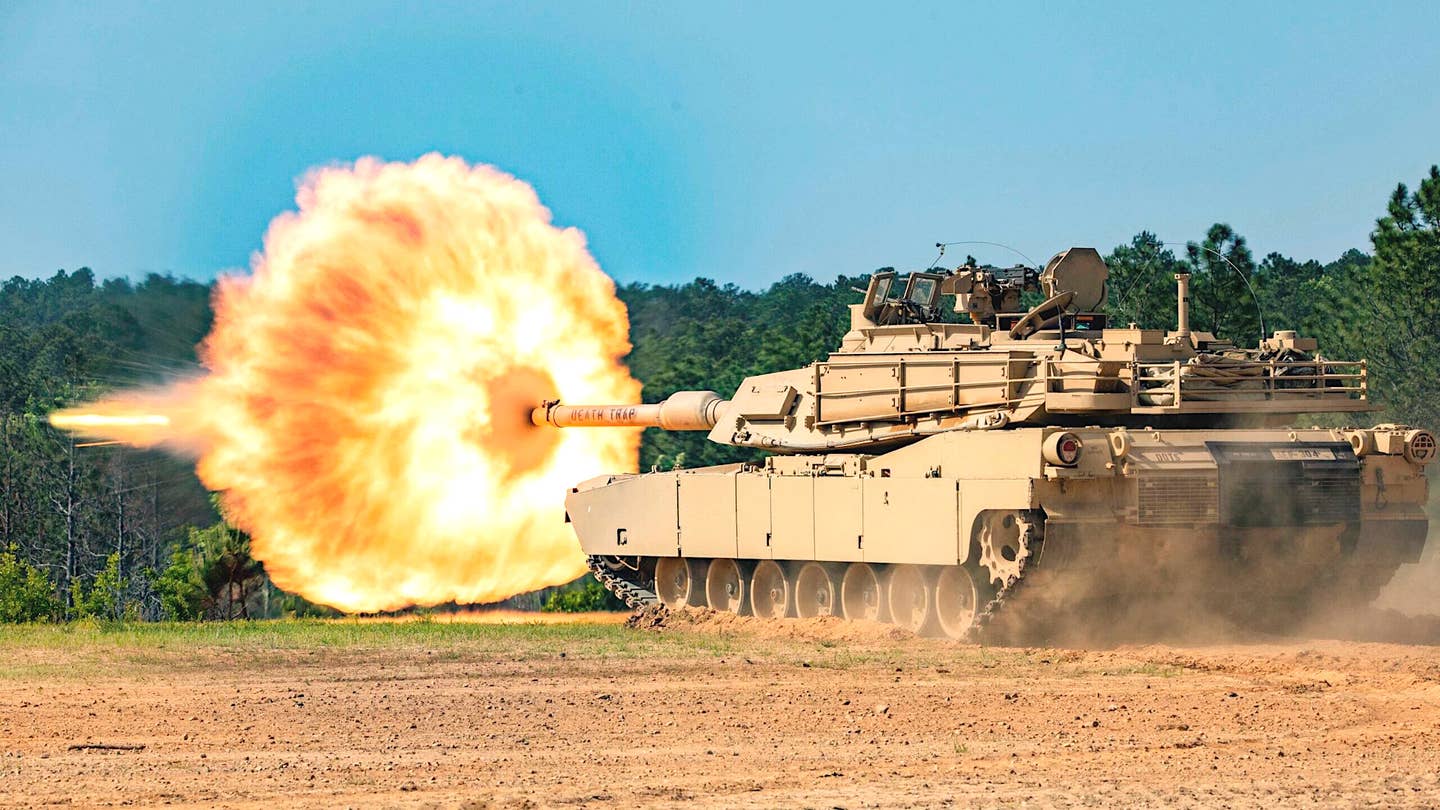
The U.S. Army's M1 Abrams tanks will "not be effective" or able to "dominate" on the battlefields of the 2040s, especially in the context of a potential high-end conflict against China. This is the conclusion of an official advisory body that is also calling for an Abrams replacement effort that could include a next-generation M1 derivative, as well as lighter 'tanks' armed with larger caliber guns and hypersonic anti-tank missiles, and uncrewed ground vehicles.
The Army Science Board, a federally-sanctioned independent group of experts that advises the Secretary of the Army, recently published an assessment about the future of the M1 tank. It also outlines the need for one or more types of "5th Generation Combat Vehicle," or 5GCV, to meet operational demands in the 2040s. The origins of this study trace back to 2019 and the final report is dated August 2023.
 A
A US Army M1A2 Abrams tank.
The Army currently has around 2,500 M1 Abrams tanks in service today, with thousands more in storage that could potentially be refurbished and returned to service, if necessary. The original M1 entered service in the 1980s and significantly more capable variants have been introduced since then.
The Army Science Board study is blunt in its core conclusions about the future of the M1, stating early on:
"Based on our findings, The M1 Abrams will not dominate the 2040 battlefield. All of the M1’s advantages in mobility, firepower, and protection are at risk. The M1A2 SEP V3&4 upgrades will improve effectiveness but will not restore dominance. Near transparency in all domains will significantly increase the lethality our forces will experience. China and Russia have studied our forces and doctrine and are fielding countermeasures. We will continue to have to fight outnumbered, exacerbated by a low MBT operational readiness rate and an aging fleet."
The term "transparency" here refers to steadily more capable adversary intelligence, surveillance, and reconnaissance (ISR) capabilities. This, in turn, makes friendly actions more 'transparent' to opponents and increases the likelihood of them being detected, tracked, and targeted.
The study reiterates its central points in its conclusion:
"The M1 will not be effective on the 2040 battlefield. Its design for protection, lethality mobility and C2 are not sufficient to dominate the 2040 battlefield."
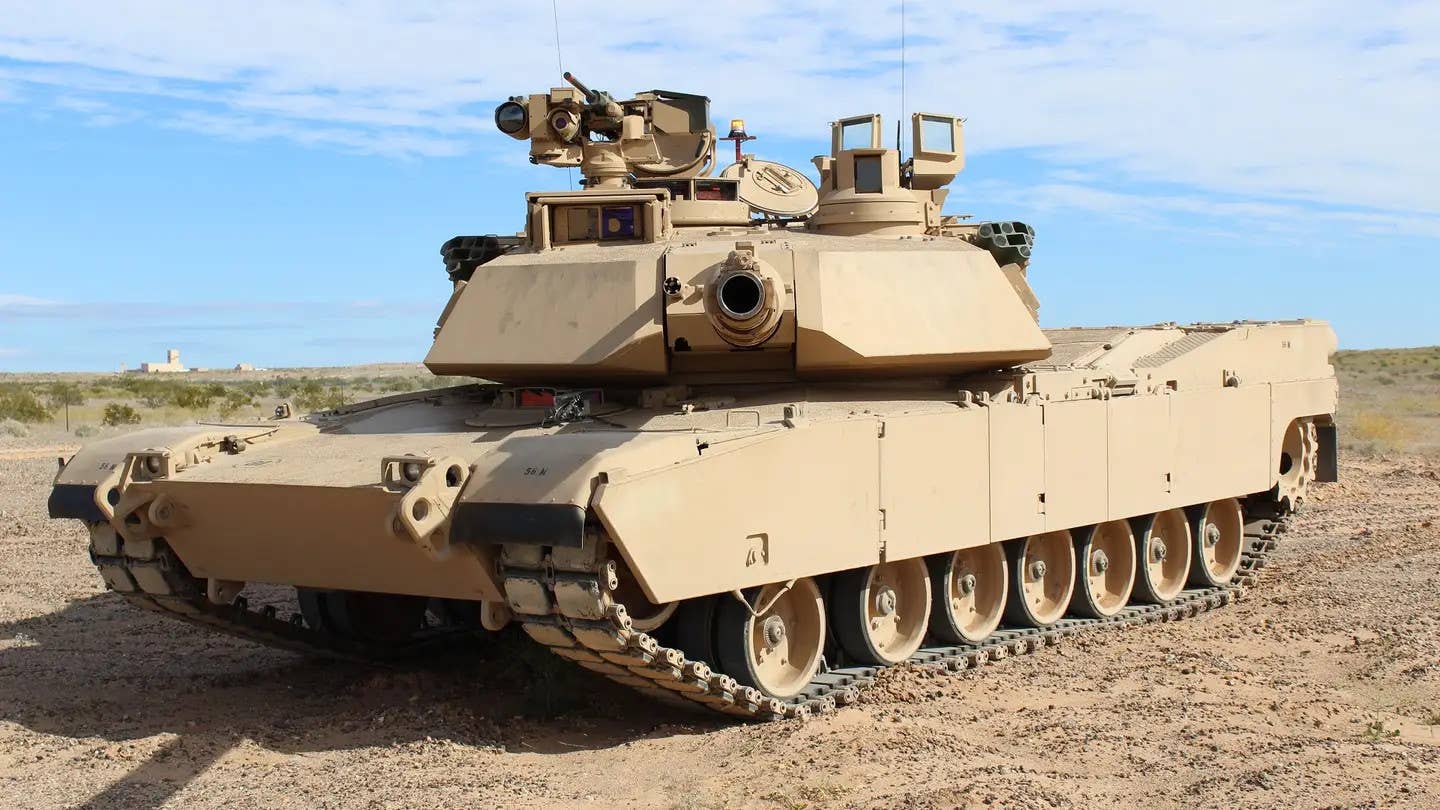
The study bases these findings on a number of different factors. The authors explicitly point to intelligence about and lessons learned from Israel's interventions into southern Lebanon in 2006 and the Gaza Strip in 2014, the 2020 Nagorno-Karabakh conflict, Russia's all-out invasion of Ukraine starting in 2022, and developments within China's People's Liberation Army (PLA) as having been key to informing their conclusions and recommendations.
"Conflict in South Lebanon in 2006 exposed shortcomings that drove changes in the Israeli Defense Force, particularly armored vehicle protection," the study notes. "The Israelis restored survivability overmatch with active protection (APS) against shaped charge ATGMs [anti-tank guided missiles] to retain the ability to close with and destroy the enemy through maneuver and fire with protection. In Operation Protective Edge [in Gaza in 2014], the IDF did not lose a single tank to ATGM fire, including in very close terrain."
Israeli defense companies have been and continue to be pioneers in active protection systems for armored vehicles. For years now, the Army has been in the process of integrating an Israeli-designed APS, Rafael's Trophy, onto its M1 tanks. Trophy is a so-called hard-kill APS designed to defeat certain types of threats by physically intercepting them. Soft-kill APS designs that work by either setting off incoming threats before they reach the vehicle or by preventing them from functioning properly at all also exist.
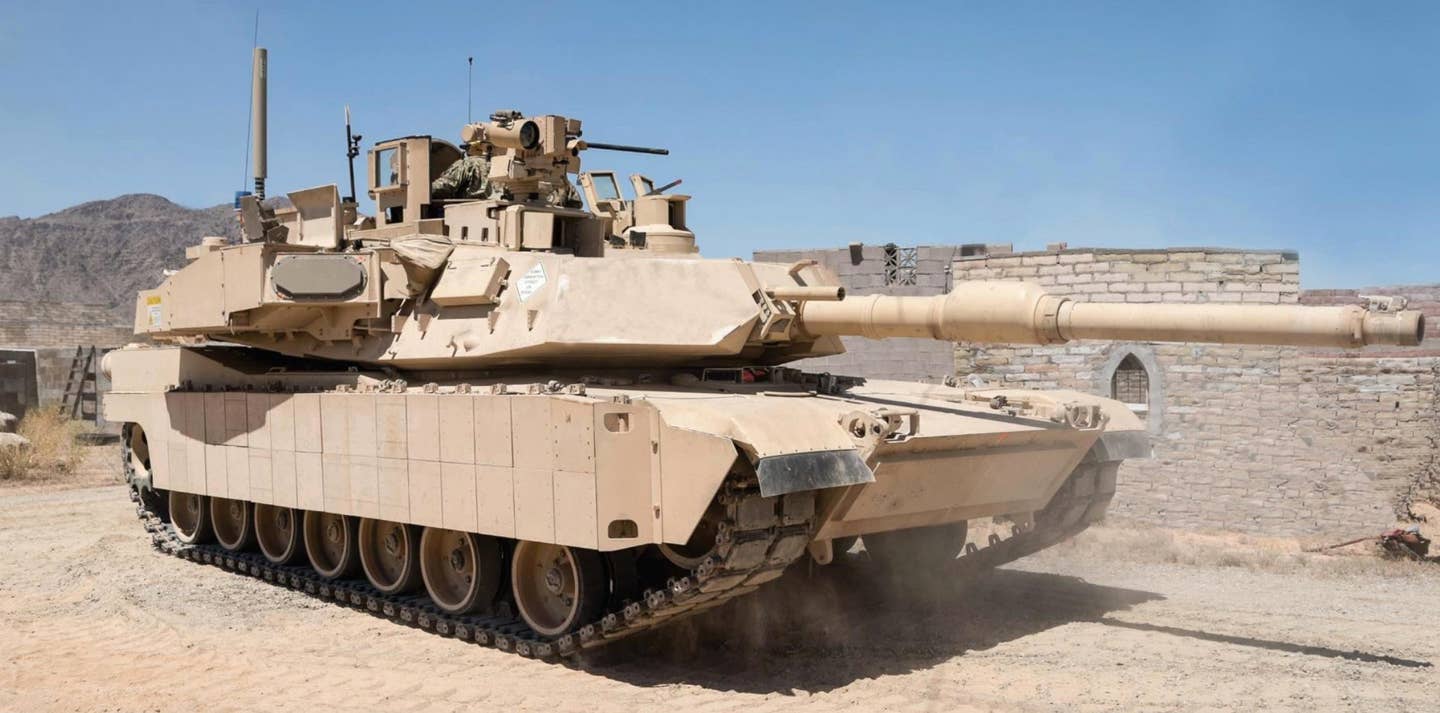 An M1 Abrams tank with the Trophy APS installed. U.S. Army via Leonardo
An M1 Abrams tank with the Trophy APS installed. U.S. Army via LeonardoHowever, "the Nagorno-Karabakh and Ukraine wars ... exposed vulnerabilities from ATGMs, armed unmanned aerial vehicles (UAV) and loitering submunitions, antitank mines, and the dangers of increasing battlefield transparency," the report adds.
Furthermore, "insights from recent conflicts, analysis of the PLAA [the People's Liberation Army Army, or China's ground forces] and Chinese R&D, and longer-term technology trends all point to a battlefield that is expanding across multiple dimensions, modes, and domains of warfare and geography and actors, and increasing in complexity," it continues. "While battles will still be fought over localized objectives, battles, campaigns, and conflicts will routinely involve global inputs and consequences. Notably, the battlefield is not expanding in time. The speed of information, events, and weapons systems are accelerating, compressing decision cycles and reaction times."
The Army Science Board highlights how the scale and scope of potential threats to tanks and other armored vehicles only continue to grow. This already includes increasingly more capable ATGMs and other infantry anti-tank weapons, and drones. In addition, potential adversaries, especially near-peer competitors like China, are increasingly able to integrate "effects from air, sea, space, cyber, and electromagnetic spectrum operations" to support efforts on the ground.
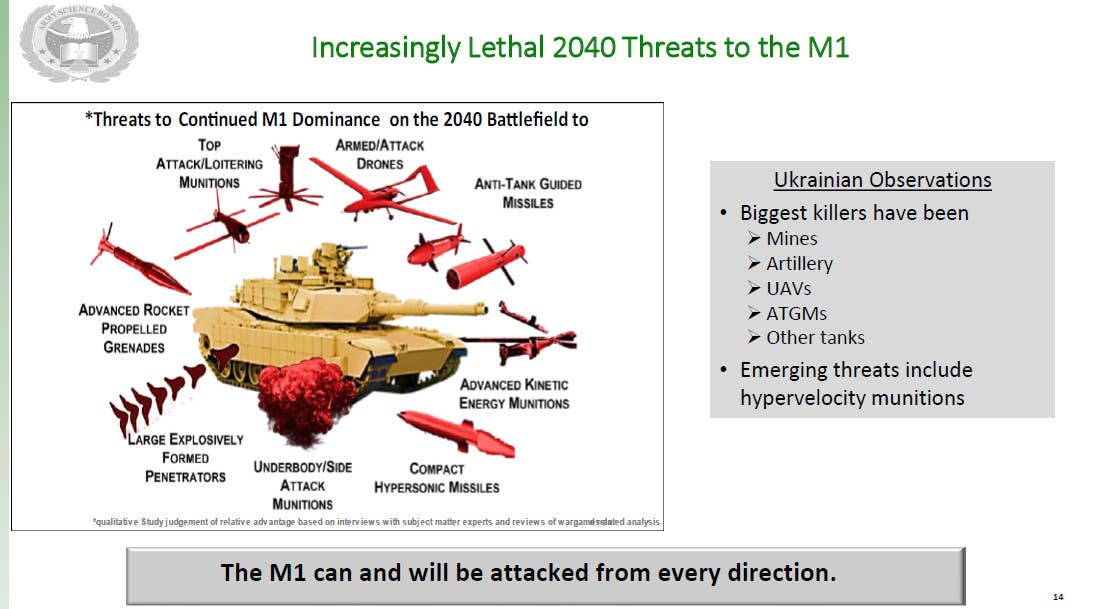
A slide from a briefing accompanying the Army Science Board's report that gives a general overview of existing and emerging threats the M1 Abrams is facing. Army Science Board
"The 2040 battlefield will likely see significant increases in the use of robotics for combat, ISR [intelligence, surveillance, and reconnaissance], and logistics functions; AI [artificial intelligence]-aided capabilities to include target location and identification and platform movement; cyber-attacks on command-and-control facilities; longer-range indirect fire systems (both artillery and rockets/missiles) with increasingly capable precision munitions that can defeat anything they can acquire," the Army Science Board assesses.
"The future battlefield will place a premium on camouflage, cover, concealment, deception, and denial (C3D2) using new technologies that can defeat, disrupt, confuse, and/or spoof enemy sensors and cyber capabilities that can interrupt, confuse, deceive, and even take over enemy command and control systems to desynchronize enemy capabilities," the board's report adds.
It is worth noting here that reducing signatures, in the infrared and radiofrequency spectrums, has long been a focus area for armored vehicle designers. Infrared signature-reducing coverings and coatings are already in service on tanks and other armored vehicles in many countries, including the United States. There has been experimentation with various active camouflage concepts, as well.
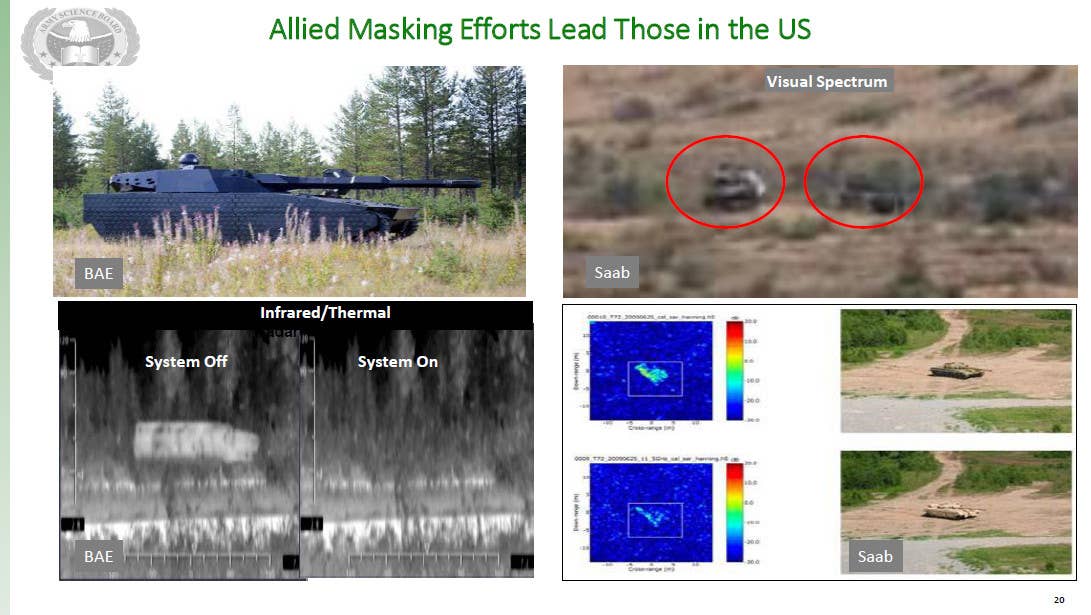 A slide from a briefing from the Army Science Board about its armor study that gives a look at some relevant signature "masking" developments. Army Science Board
A slide from a briefing from the Army Science Board about its armor study that gives a look at some relevant signature "masking" developments. Army Science BoardGround-based electronic warfare capabilities, both as a tool to find enemy forces and to help protect friendly units, are also key components of this equation.
There has also been a broader revival in interest in camouflage, concealment, and deception tactics, techniques, and procedures. This is something that has only been further driven by the conflict in Ukraine, where decoys of various types, in particular, are being very actively used on both sides. In the U.S. military, it is not just the Army that is taking a new look at ways to hide its movements and deceive the enemy, as you can read more about here.
Altogether, the study outlines a future where traditionally configured modern main battle tanks (MBT) are increasingly unlikely to be a dominating presence. This includes the latest versions of the M1 Abrams, which are very heavy, negatively impacting their mobility, and have defensive capabilities that are still primarily centered on passive and reactive armor rather than active defenses. Just in terms of weight, the Army's newest M1A2 System Enhancement Package Version 3 (SEPv3) variant tips the scales at between 76 and 78 tons with a full combat load, more than 20 tons heftier than the original M1 that entered service in the 1980s.
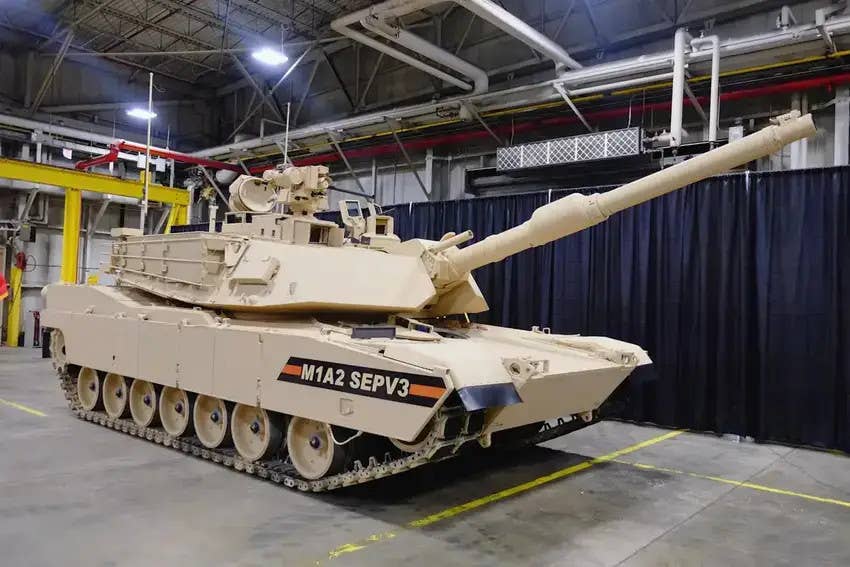 A picture of the M1A2 SEPv3 prototype. General Dynamics Land Systems
A picture of the M1A2 SEPv3 prototype. General Dynamics Land SystemsThe Army Science Board says these issues would be further exacerbated in the context of any future major conflict in the Pacific region due to the demands that would come from having to deploy and sustain traditional heavy armored units across very long distances. The recent study highlights long-standing concerns about the lack of adequate sealift capacity and the limitations of moving heavy armor by air.
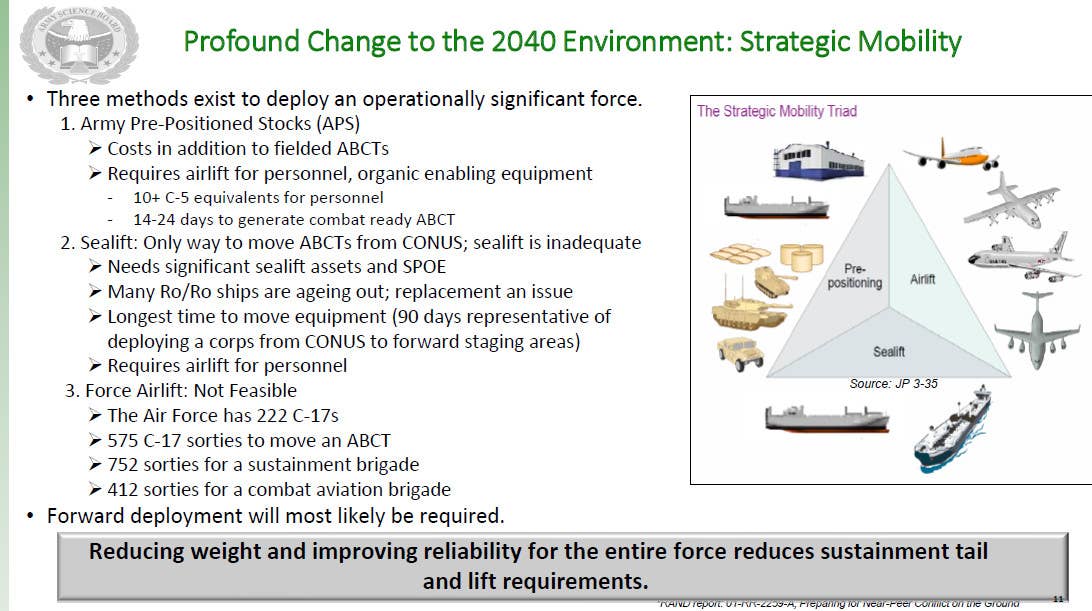 A briefing slide outlining strategic mobility challenges when it comes to moving US Army Armor Brigade Combat Teams (ABCT), including their M1 tanks. Army Science Board
A briefing slide outlining strategic mobility challenges when it comes to moving US Army Armor Brigade Combat Teams (ABCT), including their M1 tanks. Army Science BoardIn addition, the U.S. military makes no secret of its concerns about supporting forces in a future high-end fight against the PLA, which would be expected to actively contest friendly supply chains.
"The study team conducted a tabletop wargame using a near term Taiwan scenario supported by the Center for Army Analysis," the report explains. "This wargame demonstrated armor’s value in Taiwan’s defense but struggles with deployment and sustainment precluded US armor’s arrival in sufficient numbers before China achieved a fait accompli. A review of classified wargame reports and other analysis suggested similar challenges with deployment and sustainment."
U.S. officials have expressed concern on multiple occasions about the PLA reaching a point where it would feel confident in succeeding in a military intervention against Taiwan well before the end of the decade. Taiwan has been working to bolster its own defense posture in a multitude of ways, including through the planned acquisition of new M1 Abrams tanks.
"Related to the South China Sea, the study examined the implications of 'third-party intervention' by China in Korea. Northern Theater Command, with the capability and capacity to act without outside support, intervention would prevent unification of the peninsula following regime collapse or escalate horizontally, splitting US forces between Korea and Taiwan," it adds. "Both scenarios involved potential US and Chinese armor engagements, highlighting the challenges of fighting outnumbered against a fully modernized armor/anti-armor force able to generate combat power at speed, scale, and reach."
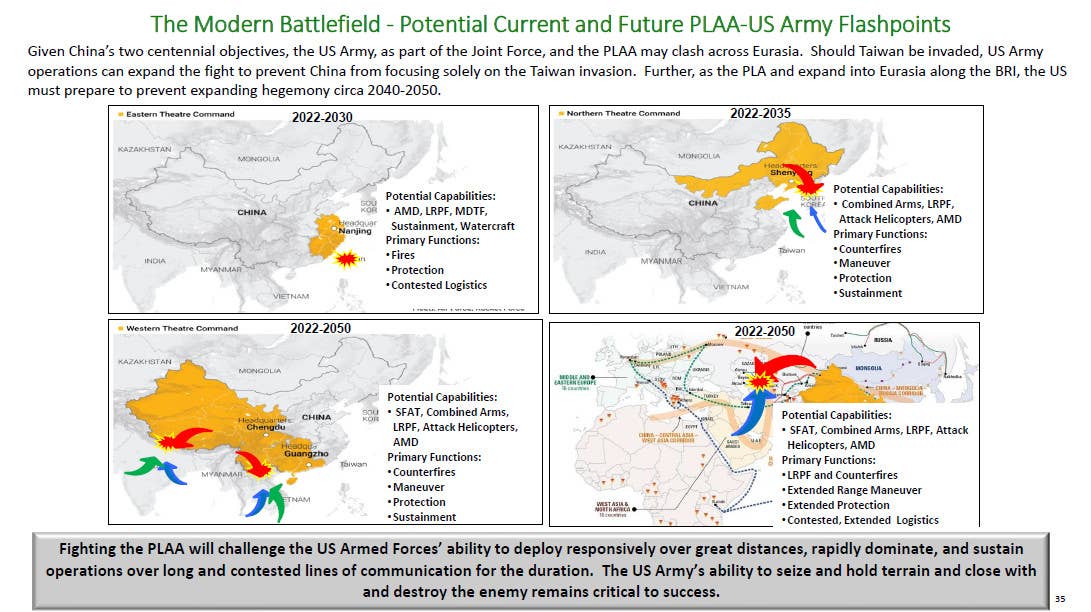 A briefing slide that gives a general overview of potential flashpoints where the US Army and Chinese ground forces (PLAA) could become engaged, and the kinds of capabilities and challenges that could come into play. Army Science Board
A briefing slide that gives a general overview of potential flashpoints where the US Army and Chinese ground forces (PLAA) could become engaged, and the kinds of capabilities and challenges that could come into play. Army Science BoardThe study also notes that deployability and operational sustainment issues when it comes to Army armored units are not solely the fault of the M1. The authors highlight the service's new Armored Multi-Purpose Vehicles (AMPV) and its plans for a Bradley Fighting Vehicle replacement, tentatively referred to now as the XM30, as examples of other armor developments they see as heading in the wrong directions.
The AMPVs are based on the existing Bradley design and are significantly larger than the M113 armored personnel carriers (APC) and related vehicles they are supplanting. Whatever design is ultimately selected to become the XM30 is expected to be bigger and heavier than the already notoriously bulky Bradley.
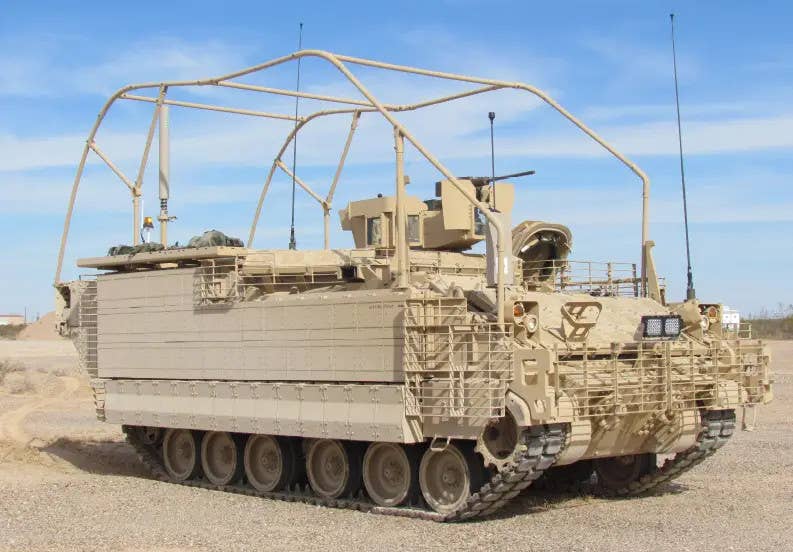 An armored personnel carrier variant of the AMPV with various add-on features, including explosive reactive armor (ERA) tiles along the side and a tubular frame on top to deflect wires and similar hazards. BAE Systems
An armored personnel carrier variant of the AMPV with various add-on features, including explosive reactive armor (ERA) tiles along the side and a tubular frame on top to deflect wires and similar hazards. BAE SystemsAltogether, "discussions with Army leadership and retired General Officers who exercised joint responsibility in Europe and the Indo-Pacific indicate the necessity of a relook at the weight of the MBT," the study explains. "All agree that the M1 at 70 tons or greater is not tactically, operationally, or strategically mobile. It is therefore important to explore the feasibility of significant weight reduction in a next-generation MBT without compromising its protection specifically and operational capability generally."
Still, the authors of the Army Science Board report stress that they are not explicitly advocating for one or more specific solutions to these problems. The study does outline a number of potential concepts it feels the Army should start exploring right now, including through live experimentation with testbeds, in order to ensure it has the right mix of capabilities by 2040.
The lowest risk option the experts offer is a lighter 55-to-60-ton M1-derived tank with an advanced 130mm main gun, reduced crew, a hybrid-electric propulsion system, and a focus on active rather than passive defenses, among other features. A rendering of a potential notational design included in the study, seen below, shows a vehicle with a remote weapon station on top of its main turret armed with a machine gun and ATGM, as well.
 Army Science Board
Army Science BoardInterestingly, the Army has already highlighted its intention to more or less do just this. In September, the service announced it was axing the M1A2 SEPv4 upgrade plan for the Abrams in favor of a next-generation tank that is expected to have many of the features outlined in the Army Science Board report. That the study's final report was published just the month before makes it very possible, if not probable, that it had a direct influence on this decision. The service also said that the Abrams had reached the limits of what the chassis would support weight-wise.
Many of the features the Army Science Board says are desirable in a lighter-weight M1 follow-on design are also ones that the company currently behind the Abrams, General Dynamics, has incorporated into an AbramsX demonstrator design. The AbramsX was first unveiled last year.
However, the study concludes that the design resulting from this course of action would by just as problematic when it comes to "strategic mobility," that is to say its ability to be deployed and employed readily and effectively in a major conflict scenario, as the M1.
The authors therefore recommend the Army also consider a new crewed 35-to-40-ton light tank with many of the same features and a 20-to-30-ton "robotic wingman."
The light tank proposal is interesting given that the Army is also in the process of acquiring the M10 Booker. This is a 42-ton vehicle with a 105mm main gun that the service insists is not intended to function as a tank, even a light one, but will instead act as an armored mobile fire support platform for infantry units.
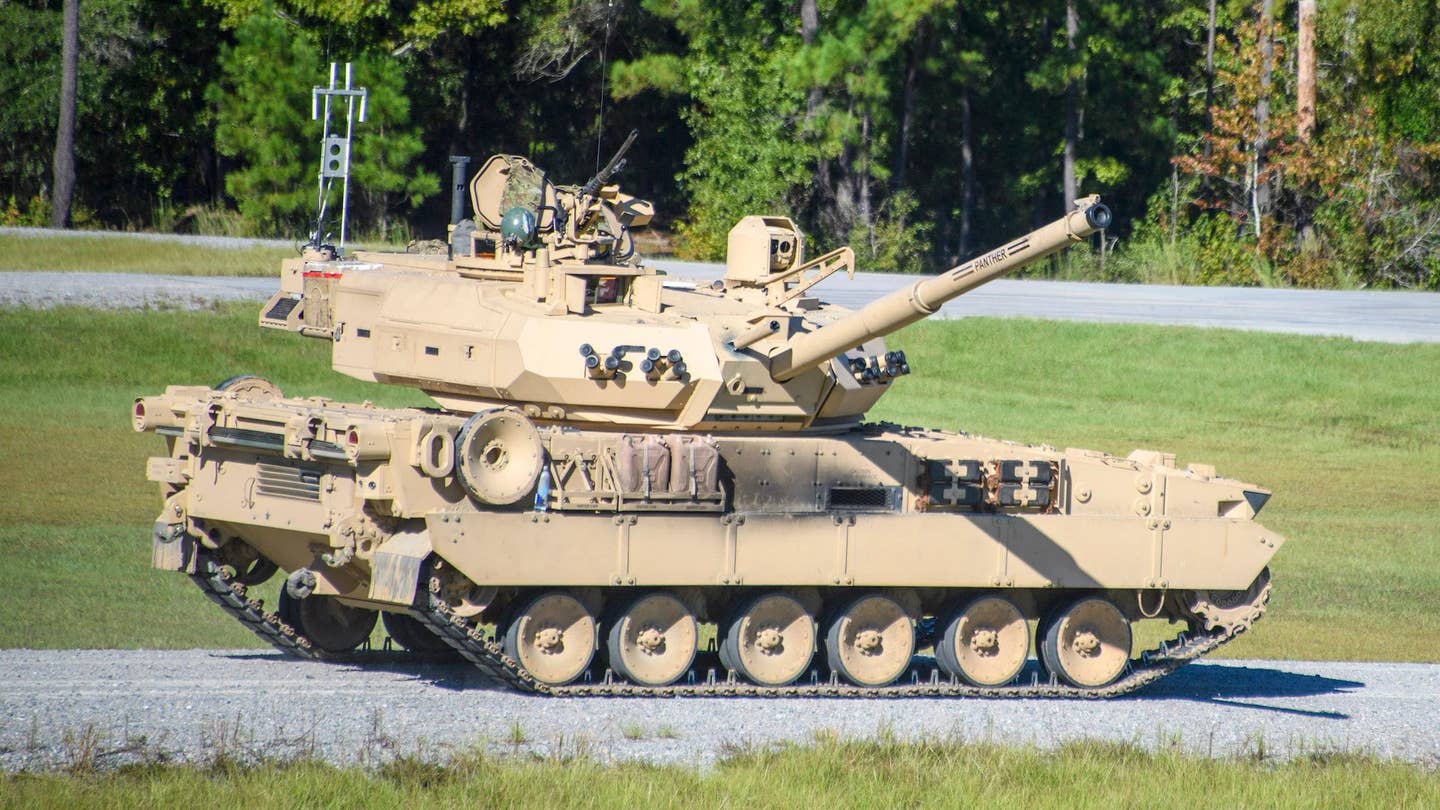 The M10 Booker. US Army
The M10 Booker. US ArmyWhat the Army Science Board describes as its light tank vision is much more of a scaled-down MBT that leverages advanced technologies to provide similar capability in a smaller package:
"While there are many technologies that could contribute to this objective, three will be explicitly listed here. First an exploration of the potential of active protection against both kinetic energy penetrators and shaped charge weapons must be undertaken to provide a basis for tradeoff between active and passive protection. Second, robotics to provide reduction in the number of crew members must be explored. The number of crewmembers is a major determinant of the armored volume and as a result, armor weight. And finally, can energetics chemistry allow use of lethal smaller main guns and failing such progress, is there a possibility for a missile firing MBT? While such lethality investigations will certainly yield progress, experimental data is required to assess whether these approaches provide sufficient weight reduction to justify any operational compromise."
In addition to the mention here of a possible 'tank' with a primary missile armament, the Army Science Board report notably mentions the idea of hypersonic anti-tank missiles multiple times, both as a potential future capability and threat. The U.S. military explored weapons of this type for decades, before largely abandoning the idea, at least publicly, in the late 2000s, as you can read more about here.
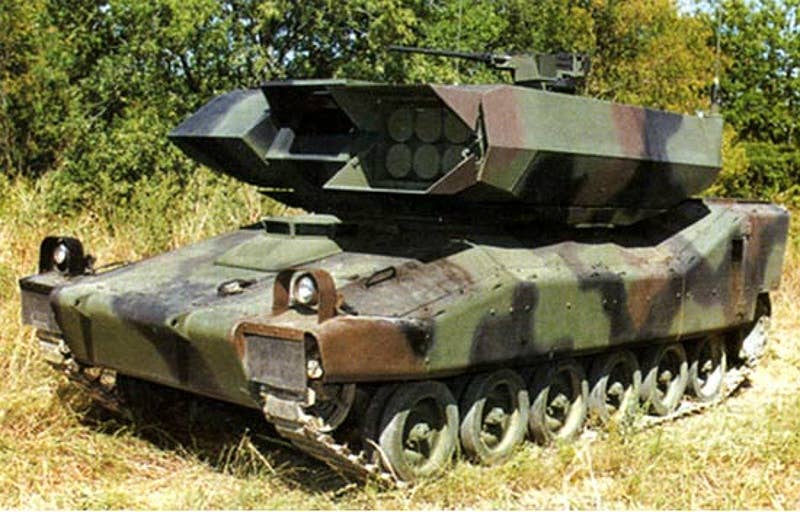 An artist's conception of an armored vehicle armed with Line-of-Sight Anti-Tank (LOSAT) high-speed anti-tank missiles, from circa the late 1990s. This vehicle's chassis is also based on the abortive M8 Buford light tank. US Army
An artist's conception of an armored vehicle armed with Line-of-Sight Anti-Tank (LOSAT) high-speed anti-tank missiles, from circa the late 1990s. This vehicle's chassis is also based on the abortive M8 Buford light tank. US ArmyThe idea of a "robotic wingman" tethered to a crewed platform, or even a more semi-autonomous uncrewed ground vehicle, optimized for anti-tank and other fire support missions, is something that the Army has already been publicly pursuing for years now. The Army Science Board's proposal here is very much in line with plans for what has been referred to in the past as a Remote Combat Vehicle-Heavy (RCV-H).
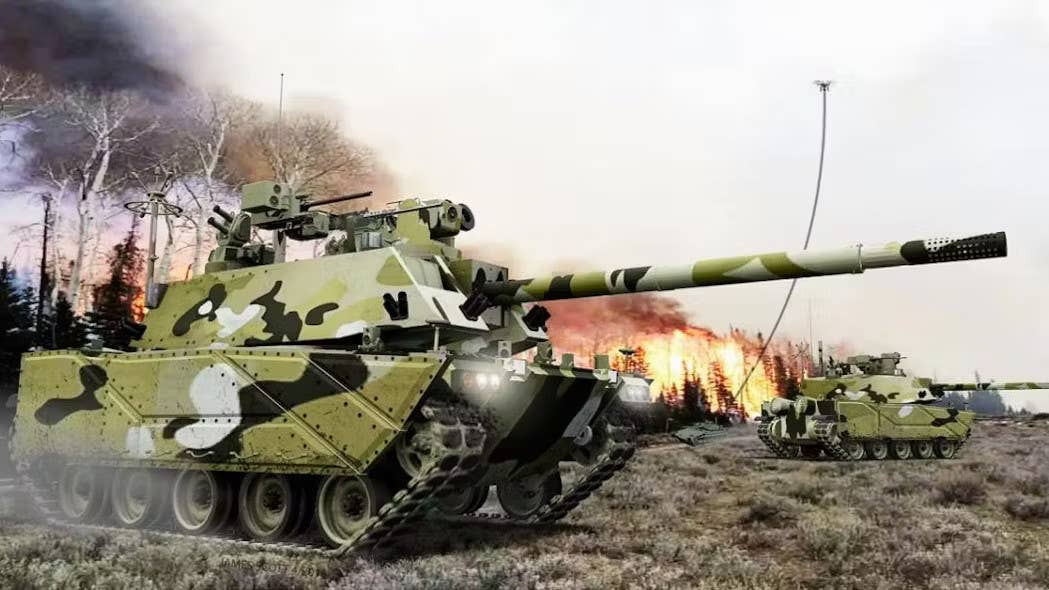 A rendering of a pair of notional RCV-H uncrewed ground vehicles. US Army
A rendering of a pair of notional RCV-H uncrewed ground vehicles. US ArmyThe Army has already been testing other types of drone vehicles to meet lower-tier RCV "light" and "medium" requirements, including the 30mm cannon-armed Ripsaw M5 uncrewed mini-tank.
These uncrewed vehicles would employed primarily as complements to crewed armored vehicles, rather than supplant them. Drone tanks could help provide a lower-cost way to increase the size of armored forces and help extend the reach and reduce the vulnerability of tanks and other platforms with actual people inside them.
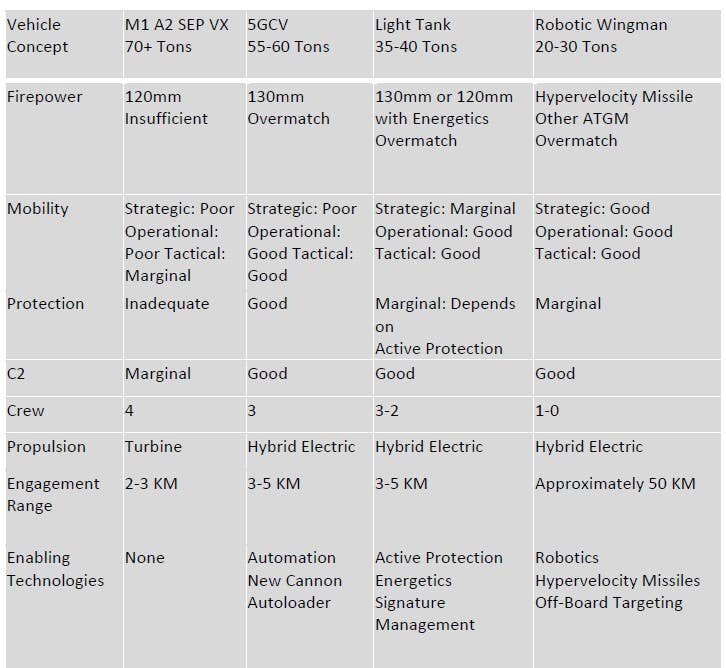 A chart offering various details about Army Science Board notional M1 Abrams alternatives, as well as a generic entry for all M1A2 SEP subvariants. Army Science Board
A chart offering various details about Army Science Board notional M1 Abrams alternatives, as well as a generic entry for all M1A2 SEP subvariants. Army Science BoardThe Army Science Board's actual recommendations for the Army include the aforementioned call to begin testing concepts now. The authors of the study also suggest the Army coordinate with the Defense Advanced Research Projects Agency (DARPA) and the Department of Energy (DoE) on the development of relevant advanced technologies. Though not widely appreciated, DoE is an important player in the development of advanced military technologies outside of nuclear weapons, especially ones requiring advanced materials science work, as you can read more about here.
The report also recommends that the Army engage with France and Germany, which are currently working together on a next-generation tank project and have been separately exploring advanced larger-caliber main guns. The Army Science Board's study also laments the lack of work like this being done now in the United States itself. In addition to the European large-caliber tank gun programs, there have been reports over the years about similar efforts in Russia and China.
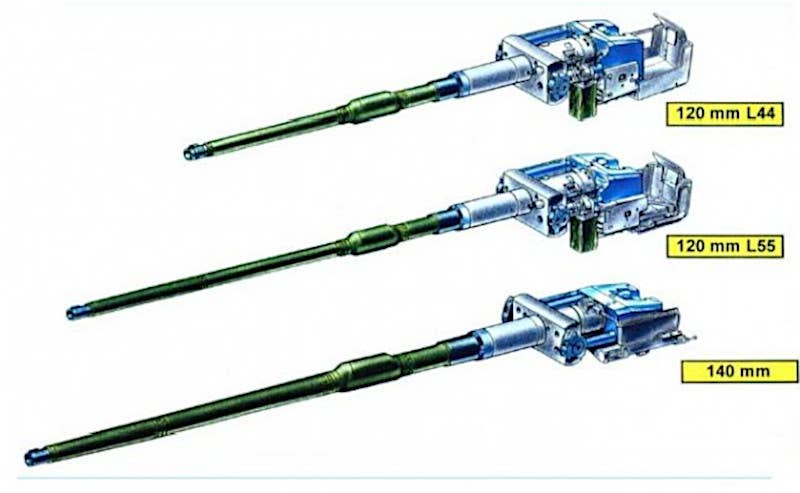 A graphic offering a comparison between the size of a 140mm gun design from Germany's Rheinmetall and earlier 120mm types. The 120mm M256 gun used on current generation M1 Abrams variants is a derivative of the Rheinmetall L44 type. The German firm has since shifted focus to a new 130mm design. Rheinmetall
A graphic offering a comparison between the size of a 140mm gun design from Germany's Rheinmetall and earlier 120mm types. The 120mm M256 gun used on current generation M1 Abrams variants is a derivative of the Rheinmetall L44 type. The German firm has since shifted focus to a new 130mm design. RheinmetallIt is worth noting that many of these issues, especially the challenges of balancing protection against weight when it comes to heavy armored vehicle design, are not new. As mentioned earlier, this particular study itself first began four years ago and directly took into account relevant data and information from real-world conflicts stretching back nearly two decades.
The Army Science Board's conclusion that the M1 will be vulnerable and insufficiently deployable by the 2040s, to the point of not being useful in a future high-end conflict in that time frame, is a stark declaration. It is also one at odds with comments from senior Army leadership in recent years about increasing the size of the Abrams fleet specifically in the context of planning for a major fight in the Pacific.
"First of all, you know, going all the way back to World War II, tanks have been an important part of the combined arms force out here [in the Pacific]. ... And by the way, Australia just purchased [new] M-1 tanks. And we trained with the Australian Army in Talisman Sabre with their newly arrived M-1s," Army Gen. Charles Flynn, head of U.S. Army Pacific (USARPAC), told members of the media just last month. "I believe that you’re gonna have the--need the entire inventory of combined arms ground maneuver in order to fight in restricted terrain. And the tank and armor capabilities in the Pacific is absolutely necessary for conducting operations out here in restricted terrain."
This all also follows the U.S. Marine Corps divesting its entire M1 tank fleet as part of a radical force restructuring effort centered in large part on making the service more readily deployable, particularly in the context of a future conflict in the Pacific.
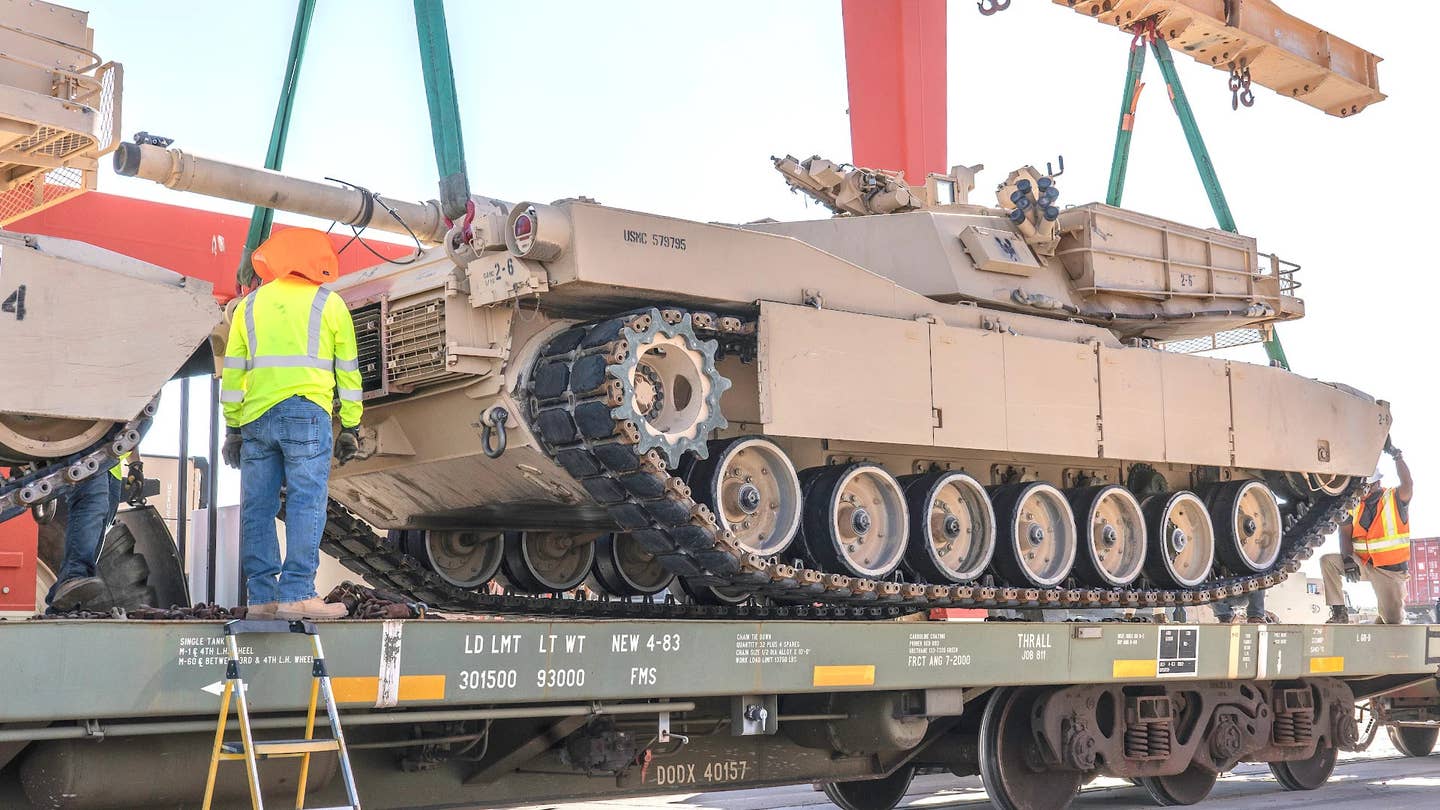 A US Marine Corps M1 Abrams is loaded onto a truck as part of the service's divestment of these tanks in 2020. USMC
A US Marine Corps M1 Abrams is loaded onto a truck as part of the service's divestment of these tanks in 2020. USMCThe Army Science Board's new study does agree with Army leaders like Flynn that armor will remain an important part of U.S. military operations in the Pacific and elsewhere for the foreseeable future. The report highlights that the current fighting in Ukraine has only reinforced this reality, despite a vigorous debate about whether this conflict has marked the beginning of the end for heavy armor.
At the same time, the report from the Army experts lays out a future where the value of traditionally configured and ever-more-overburdened tanks like the M1 Abrams will be at best questionable.
How the Army's tank and other armored units will change and evolve in the coming decades remains very much to be seen. If the Army Science Board's assessment proves to be accurate and its recommendations are heeded, the service could head into the 2040s with fleets of 'tanks' that are very different from the Abrams of today.
No comments:
Post a Comment